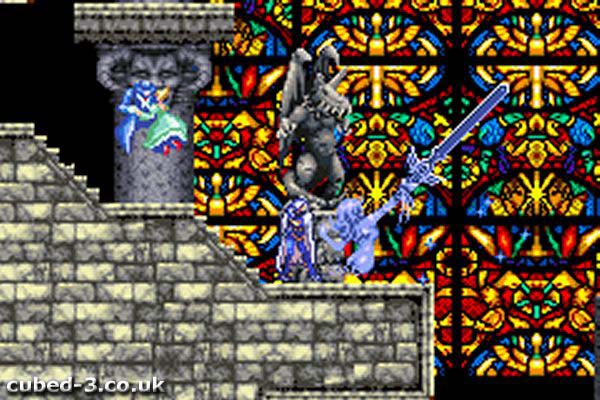Castlevania: Aria of Sorrow (Game Boy Advance) Review
By Adam Riley  01.12.2003
01.12.2003

Konami's Castlevania franchise is regarded by many as being one of the most prominent on the scene today due to its long-term existence and continually high standards in terms of quality. Therefore, whilst many believe Konami to have deserted Nintendo in this current generation, they need to remember that the GBA has been privileged to house an extraordinary trilogy of Castlevania games, coming to an end with this, Aria of Sorrow...
This is not the usual Castlevania fare as it is set 2035 and follows a character by the name of Soma Cruz, not a direct descendent of the Belmont family, but simply a high-school student that has inexplicably become encaged within the domain of Dracula himself with his friend Mina Hakuba and a wealth of evil creatures as his only company. Soma soon realises that he holds a very useful, and dangerous, ability, the art to transfer fallen creatures' souls onto his person, thus granting him access to whatever special power the enemy previously held. Using this technique he endeavours to make his way through the eerie environments, trying to uncover why he was brought here, who he can trust out of those he meets on his travels and, ultimately, whether he will ever be able to escape the castle's clutches.

The original GBA Castlevania, Circle of the Moon, that accompanied the handheld at launch was chastised for being so dark in graphical tone that even under a direct light-source people struggled to see exactly what was going on due also in part to the dire GBA screen with its lack of any type of lighting. To remedy this, with Harmony of Dissonance things were lightened up as well as improving upon the animation and characters models’ detail levels. But many bemoaned the fact that things were far too luminescent, thus detracting from the dark undertones that have been linked with Castlevania since its initial conception. So, for this final GBA adventure (for the time being, anyway – who knows if Konami will change its mind and release another…) there is still a slightly lighter tone to the proceedings, but the characters’ outer glows have been removed. Thus Aria of Sorrow manages to be a notch higher than HoD in terms of aesthetic beauty, with its extensive animations for all creatures, bosses and human persons and greater sized enemies that will leave players astounded at the lack of slow-down caused by them, whilst reverting back to the darker nature of the previous versions in the series. Truly the perfect mixture, and a level of quality that will take strenuous efforts to better.
Circle of the Moon’s melodic soundtrack was praised from the rooftops by all and sundry, yet the opposite is true for Harmony of Dissonance, which in comparison was a weak imitation that used low quality MIDI music to poor effect and vastly removed from the intense in-game experience. Thankfully, despite Aria of Sorrow actually being developed in tandem with HoD, its release was delayed long enough to hear the complaints from fans everywhere and make sure the same problem did not arise for a second time in a row. Therefore the increase in quality found within AoS’s musical score can help the player to forgive for the odd repetitive tune that can be stumbled upon whilst in mid-adventure. Apart from the map feature, which may confuse some when trying to navigate their way to a specific area, there are very distinctly different themes for the various sections of the castle, such as Chapel with its atmospheric pacific tones or the Castle Corridor that is far more intense. Apart from the actual music, there is the pleasant addition of voice-bites – not any actual digitised speech as such, but the odd painful outcry from an enemy as it falls, a burst of laughter from a fellow human you are conversing with, or even from Soma himself when using his special magical attacks…which, despite being simple nominal additions, all add to the game far more than would be expected, proving that little things do indeed count, after all! Hehe…

Ever since Symphony of the Night hit the PSOne and revolutionised the Castlevania series, there have been constant associations, from both fans and industry-folk alike, with Nintendo's own Metroid franchise, which is certainly no insult at all hence Konami is to be praised for borrowing from the RPG-style of adventuring for that, Circle of the Moon and Harmony of Dissonance on the GBA...and now Aria of Sorrow, the third handheld title. But do not let this lead you to believe the franchise is about to get stale any time soon, as Konami has added to the formula in this latest outing more than enough to make sure things remain as fresh as ever.
For instance, you will find the basics of AoS to be similar in nature to CotM and HoD, with the sprawling castle that is sectioned off in a way that you can find the odd warp room dotted in a different corner of the castle’s map, save rooms are littered extremely generously around the playing field and certain areas are only accessible once the previous area’s final boss has been defeated and a special ability power-up has been collected. But you do not start with a whip of any sort - all Soma holds is a little knife for warding off any oncoming enemies, which will seem very strange to start with. Thankfully you can quickly purchase, or preferably find mysteriously lying around, a greater range of weapons. In addition, the sub-weapons like the crucifix, axe and holy water from previous game have been replaced (temporarily, as they have now returned in the excellent PS2 adventure, Lament of Innocence) by the Soul collecting system, which now gives a wider scope and is far more critical to the game than the cards system in HoD – in AoS you actually will have to obtain certain souls and use them correctly to progress through certain sections and even attain one of the secret endings! You can pick these souls up by felling enemy creatures, although some will relinquish them far easier than others, with some having to be killed in vast numbers to even hope of getting its prized soul ability! There are fours types to be found – Silver: Ability, Red: Bullet, Blue: Guardian and Yellow: Enchanted. The first are normally gained after boss battles and permit the use of gameplay-furthering abilities such as sliding and doing double-jumps. Next up are the Bullet Souls that grant the techniques of the enemy you despatched and works like the sub-weapons from earlier games, for instance you can throw spears, shoot water or even launch devastating bolts of lightning at your enemies! One of the most useful Guardian Souls that you will collect later in the game is the one that transforms Soma into a bat, allowing you to reach places previously totally inaccessible. But there are many others that help in alternative ways, such as providing a magical defence for Soma or special shield. Finally there are the Yellow, Enchanted ones that will seem trivial to most as they give boosts to statistics like Luck or Strength. However, every now-and-then you will acquire one that is very useful, like the walk under water, or the water on water souls – both of which will aid with puzzles later on and access to other sections. You can use one of each coloured soul at a time, changing the required one via the menu-screen, and you need to remember that the Red and Blue souls use up your magic energy bar, which will only recover quickly by using items. It does recover naturally whilst walking, but v-e-r-y slowly.

Other welcome changes come in the areas of the castle, as well as the general layout as well. The underwater sections add an intriguing element to the series and there is a portion of the northern castle that will certainly keep gamers slightly confused for a while as they try to figure out what is going on. These may sound like small changes, but they are far superior to what EA normally does with its updated titles! Anyway, with tight controls and a general design template that not only works but works exceedingly well, why would Konami need to take any drastic steps? Perfection cannot be made any more perfect now, can it?
AoS is nowhere near as long as hoped but still a fair bit lengthier than its predecessor, Harmony of Dissonance! At least, this time around, there have been changes that try to help elongate the adventure. Whilst HoD could be polished off in a matter of hours, AoS will take even a seasoned gamer around eight hours to reach the 100% completion mark. However, this is still rather short when compared against the average 20-30 hours that normal adventure games last – although there are a few saving graces…all depending on your gaming style preferences. If, like the hordes of gamers worldwide, you are a fan of the Pokémon-themed creature collection idea / trading with friends, then the AoS experience will be furthered greatly by the temptation of ‘Soul Collecting’ and obtaining certain elusive ones via trading with friends. Gotta catch ‘em all, after all…In addition there are the now expected extras of newly accessible characters to play through the game with once initially completed (which seems a bit pointless really), a Boss Rush mode (where you face each boss in a row without a break – the ultimate test…), as well as new difficulty levels (that really would have benefited from being available right from the start!). A nice effort, but hardly what you would call completely sufficient.

Cubed3 Rating
Exceptional - Gold Award

Circle of the Moon, Harmony of Dissonance and now Aria of Sorrow – three of the best GBA titles out on the market at the moment, with this latest instalment being the superior of the pseudo-trilogy. Metroid Fusion is the only GBA game that can be compared to this series and is still, to be honest, a far better game. But Konami is rapidly closing in on the level of quality found in Nintendo’s alien-orientated adventure, making it even more of a shame that the chances of a brand new Castlevania handheld title are very slim at the moment. Perhaps if the excellent Lament of Innocence performs well enough on the PS2 there will be enough funds for another GBA outing. One can only hope so!

![]() 9/10
9/10
![]() 9/10
(3 Votes)
9/10
(3 Votes)
 Out now
Out now  Out now
Out now  Out now
Out now  Out now
Out now Comments
Comments are currently disabled

 Sign In
Sign In Game Details
Game Details Subscribe to this topic
Subscribe to this topic Features
Features





 Top
Top

